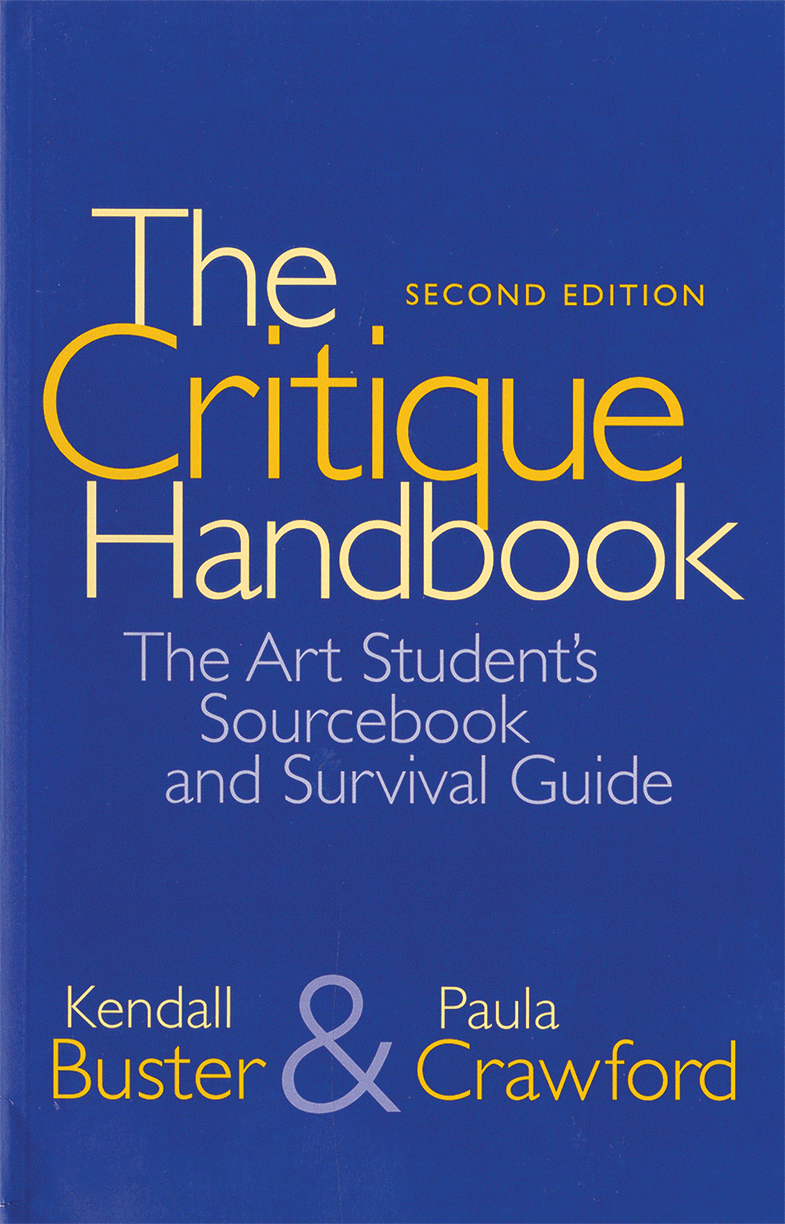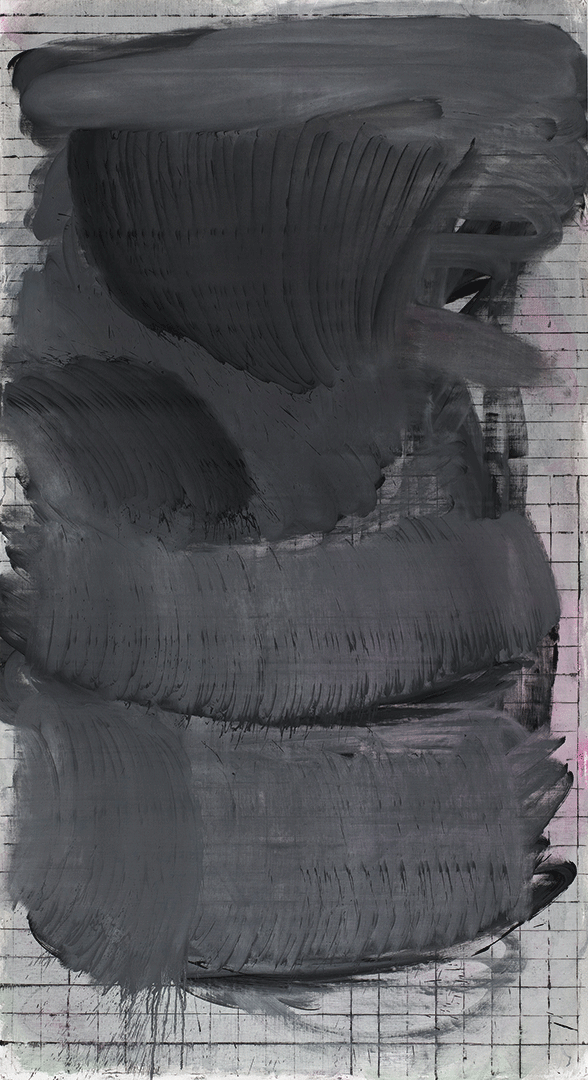« Features
Making is Critique / Looking is Critique / Dialogue is Critique
By Kendall Buster and Paula Crawford
The word critique (and the related words critic, criticism, critical, criterion) all come down to us from a family of words in Greek that refer to judging, distinguishing, and selecting. And true to its own etymology, the critique is a place of reckoning, where an artwork in which the student artist has become personally invested is examined and judged by others. These twin actions of the selective and the judgmental operate in a highly charged arena when played out in the formal art school critique. This ritual—often regarded as an end in itself, a goal toward which each student’s production is aimed—presumably occurs on neutral ground with a group of objective participants all speaking the same language.
The reality, however, is that every critique is a site for a complex play of contingent factors that have to do with 1) the timing of the critique within the student’s artistic development, 2) the psycho-social dynamic produced by the various participants in the room, and 3) the very terms of the work’s production. These contingencies make critiques less static, less objective, and less dislocated from production than we might think.
Start with timing. The critique event is located in what is a provisional moment in a trajectory that has no clear endpoint. This trajectory is the artist’s studio practice itself, and the critique the instant at which any given work is accessed. When an artwork is brought (sometimes inchoate) from the studio into the glare of public discourse, the timing within the evolution of the student’s production can seem random. This is the case because most artworks are conceived of and/or made outside the critique room, and then moved from a private to a highly unnatural public space under a whole range of conditions. The work is artificially dislocated and, in a sense, prematurely finished. Even works that collapse studio action into public performative action still involve private planning, conception, and incubation before any conscious moves to bring the studio to the public sphere, where they might be realized for the first time. Hence, every presented work is always ‘in process’ within the context of the artist’s larger studio practice no matter the level of completion; and every critique occurs at a chance moment on this trajectory.

Kendall Buster and Paula Crawford, The Critique Handbook: The Art Student’s Sourcebook and Survival Guide. 2nd Edition. Pearson, 2009.
But what is this moment? And where are we on this path at any given critique event? A work that appears successful and accomplished might actually be the product of a student who is operating safely within a comfortable known territory, closed to real growth. On the other end of the spectrum are works that show up for critique seemingly unresolved and ripe for disapproval. Presented with a work that at first glance appears to be a product of indifference or even carelessness, we may well fail to recognize the beginning of some new exploration with enormous potential. The nature of critique timing is such that a moment in an artist’s development that is, in truth, a brief resolution point might be overly praised while an awkward beginning that is actually a door to impending growth will be misread and undervalued.
Thus, no work presented at critique can really be viewed as an autonomous and singular object, suspended outside of time. Works that seem deficient may actually be potential disguised as failure. And failures may, in fact, mark the beginnings of marvelous things still unformed in a young artist’s larger studio development. If we judge without reference to the larger arc of a studio practice, we may overlook or dismiss such works in favor of the easy victories of the known.

Craig Drennen, ORANGE BANDIT (♪HO♪♪), 2019, oil, alkyd on canvas, 18” x 18” + 16” tall bag. Courtesy of the artist. Craig Drennen is a celebrated mid- career artist. His work has been featured in ARTPULSE, The New York Times, the Boston Globe, Artforum, and Art in America, among other publications. In 2018 Drennen was awarded a Guggenheim fellowship.
This requires an adjustment, or recalibration. Rather than a singular goal or deadline, perhaps the critique is more like a moment in a series of cadences that partition creative productivity, a marker of a perpetual beginning or a freeze-frame in a continuous and evolving studio practice. This allows the critique to be a useful tracking device rather than a final verdict, a cross-sectional look at an ongoing activity, rather than a place where works are ranked. Such a distinction favors process over product, the means over the end, and arguably, a belief in a necessary fluidity between the artist, the creative act, and the possibilities of a particular work.
If one contingency in critique is the arbitrary moment where the work meets the world, another involves the critique’s participants. Who is in the room? Critiques are never neutral because at any given time the random intersection of players in the conversation, opinions, levels of experience, prejudices, ideological positions (be they acknowledged or not, conscious or unconscious) form a complex collision of factors that construct a critique event. Nowhere is serendipity more in play than in the bringing together in a room such a host of diverse personalities as they try to find a language not only common to each other but one germane to a given work. A whole range of expectations, training, identities, vocabularies, descriptive systems, and worldviews may be in contention before a work is even presented.

Critique in an Undergraduate Advanced Studio Class. Department of Sculpture and Extended Media, Virginia Commonwealth University.
Is there a common ground where even the language we use in critique can signify a shared view of a work, or are there irreconcilable paradigms that form an obstacle course to precise and clarifying dialogue? In addition, some works may consciously embody opposing qualities and seek such contradiction.
Formed out of a jumble of viewpoints and agendas, a critique then is essentially a group exercise in the creation of meanings, with each viewer-participant adding another layer of significance through words or actions, and, in a real sense, performing a series of momentary completions. Hence, works in critique are actually in a constant state of being remade and refinished, rendering them always in play.
But critical dialogue begins long before a work appears in the critique room. Indeed, this dialogue occurs at all stages of any studio practice. For the making of a work is itself a critique in that every action in the studio is a critical assessment of the last action. It’s a response to the call of a perceived yearning (or deficit) in the work, played out in an incremental series of actions that arise out of looking and thinking critically.
How much of this shadow space, this memory of the studio, is present in a critique? It may vary according to how material-based or process-driven a work is, or whether conception and implementation sidestep the studio altogether. But certainly in studio practices that include some investigation around the notion of process as content, the studio as site of action remains central to any discussion of the work.

Kim Pluskota, Ucayali, 2019,wood and acrylic paint, 75” x 43” x 20." Courtesy of the artist. Early career artist Kim Pluskota earned her M.F.A. in Painting at the Savannah College of Art and Design in the spring of 2019. This artwork was part of her thesis exhibition "Of a Sacred Nature” (August 19 - September 13, 2019) at the Eula Bass Lewis Gallery in Ellisville, Mississippi. In this program her work was rigorously critiqued in thirteen studio courses and in two graduate reviews.
Thus, between studio and critique space there is always a porous boundary. And works that seemingly call for a formal reading may really demand an awareness of the maker’s actions on the material. The push, the lean, the smoosh, the poke, the tear, the bind, the slather, scrape, slice, or rip, are not just visual effects but assertions of the body’s agency. Here the critique might become a set of efforts to unpack a work by retracing the history of critical decisions (actions) inherent in its making, while still not ignoring the complex associations and referents that such a work might also contain. And what of a work brought to critique from a studio that is less a place for making than it is a site for research? Can we access the work by also accessing the terms of that research?

Todd Schroeder, Gray, 2018, oil on linen, 79” x 43.” A mid-career celebrated artist, Todd Schroeder, has exhibited in numerous international museums and galleries. His work has been critiqued in reviews in publications such as ARTPULSE and BURNAWAY.
Whether we are considering works informed by material exploration, data translation, imagery found and transformed, fusions of the found and the made, or any other processes in a vast range of practices, we still toggle between private and public, always confronting such works at a provisional moment. If we see the object of critique as less autonomous, less discrete and singular, if we see the boundaries between artist and viewer, private and public as softer and less distinct, then critiques can operate fluidly as direct actions layered onto works, which reiterate, or even extend, the studio process itself.
If we don’t recognize that the critique is part of a larger critical inquiry, fraught with chance and contradiction, then we may find ourselves disconnected from its full dynamics in a way that prevents our dialogue from being as rich as it might otherwise be. By the same token, if we can see the critique as an extension of an artist’s practice rather than a deadline or exhibition—its character less proscenium and more in the round—it can become a creative space where works are continued and even re-imagined.
Paula Crawford is co-author of The Critique Handbook, now in its second edition and recently published in China. A painter with national and international exhibitions, Crawford is a Woodrow Wilson Visiting Fellow and an alumna of the Whitney Museum of American Art Independent Study Program. She holds an MFA in painting from the San Francisco Art Institute and also studied comparative literature and classics, with a graduate fellowship in University of California Berkeley’s Comparative Literature department.
Kendall Buster is co-author of The Critique Handbook. She was a participant in the Whitney Independent Study Program and holds an MFA in sculpture from Yale University. Her large-scale architectural installations have been exhibited nationally and internationally. Buster was the recipient of a 2005 American Academy of Arts and Letters Award in the Arts and is a professor in the Department of Sculpture and Extended Media at Virginia Commonwealth University.



































Leave a Reply
You must be logged in to post a comment.